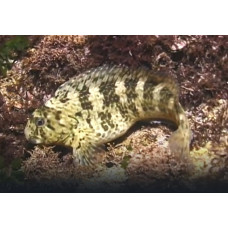Latin name
Parablennius sanguinolentus
Other name
Black Sea blenny
Identification
The body of the Rusty blenny is relatively deep. It is rounded anteriorly and compressed posteriorly. The skin is smooth, lacking scales, and covered in mucus. The head is rounded, with a forward-curving snout profile. The head bears short, filamentous, branched cirri above the eyes. The mouth is small, with 34–38 incisor-like teeth in the upper jaw, followed by one canine tooth on each side. The lower jaw has 32 similar incisor-like teeth, also followed by two canines that fit into depressions in the upper jaw when the mouth is closed.
Features of Fish Fins
The dorsal fin has 11 spines and 21 soft rays. The anal fin possesses 21 soft rays and no spines. The dorsal fin is of uniform height, with a slight notch between the spiny and soft-rayed portions, extending to the caudal peduncle, with which it is connected by a small membrane. The anal fin is positioned below the dorsal fin and is connected to the caudal peduncle by a short membrane. The pectoral fins are broad and as long as the head. The pelvic fins are filamentous.
Coloration
The back and sides of this fish are greenish, greyish-yellow, or olive with black spots, while the belly is yellowish.
Distribution
The species' range encompasses the Black Sea, the Bosporus Strait, the Sea of Marmara, the Mediterranean Sea, and the adjacent Atlantic Ocean from the Bay of Biscay to Senegal and Morocco, including the Madeira and Canary Islands.
Habitat
A subtropical, demersal (bottom-dwelling), non-migratory fish. It inhabits coastal shallows of the littoral zone among rocks and stones covered with filamentous algae (Cystoseira spp.), where it can be found year-round.
Size
The total length of individuals of this species can reach up to 23 cm, but they are typically around 12.5 cm.
Behavior
The Rusty blenny seeks out a safe refuge for its eggs. This is typically a crevice within a pile of stones, an abandoned mollusk shell, a hollow tubular bone, or even an empty bottle. The father of the future offspring diligently guards the eggs. He remains with them even when receding water levels leave the eggs exposed on the shore.
Food and Feeding Habits
Their diet consists almost exclusively of coastal red, brown, and green algae. Animal matter (mollusks, juvenile crabs, and amphipods) is occasionally found in their stomachs but appears to be of little nutritional significance.
Reproduction
Spawning occurs from April to June, sometimes extending into July. Females deposit adhesive eggs, which develop over a period of 15–20 days. The larvae and juveniles lead a pelagic lifestyle.
Fishing
This species is not commercially important.
Relationship with a person
Harmless. Used in aquariums.
| Classification | |
| Phylum | Chordata |
| Class | Actinopterygii |
| Squad | Blenniiformes |
| Family | Blenniidae |
| Genus | Parablennius |
| Species | P. sanguinolentus |
| Features | |
| Conservation status | Least Concern |
| Habitat | Bottom |
| Life span, years | No information |
| Maximum body weight, kg | No information |
| Maximum length, cm | 23 |
| Sailing speed, m/s | No information |
| Threat to people | Not edible |
| Way of eating | Planktonophage |
Rusty blenny
Tags: rusty blenny




